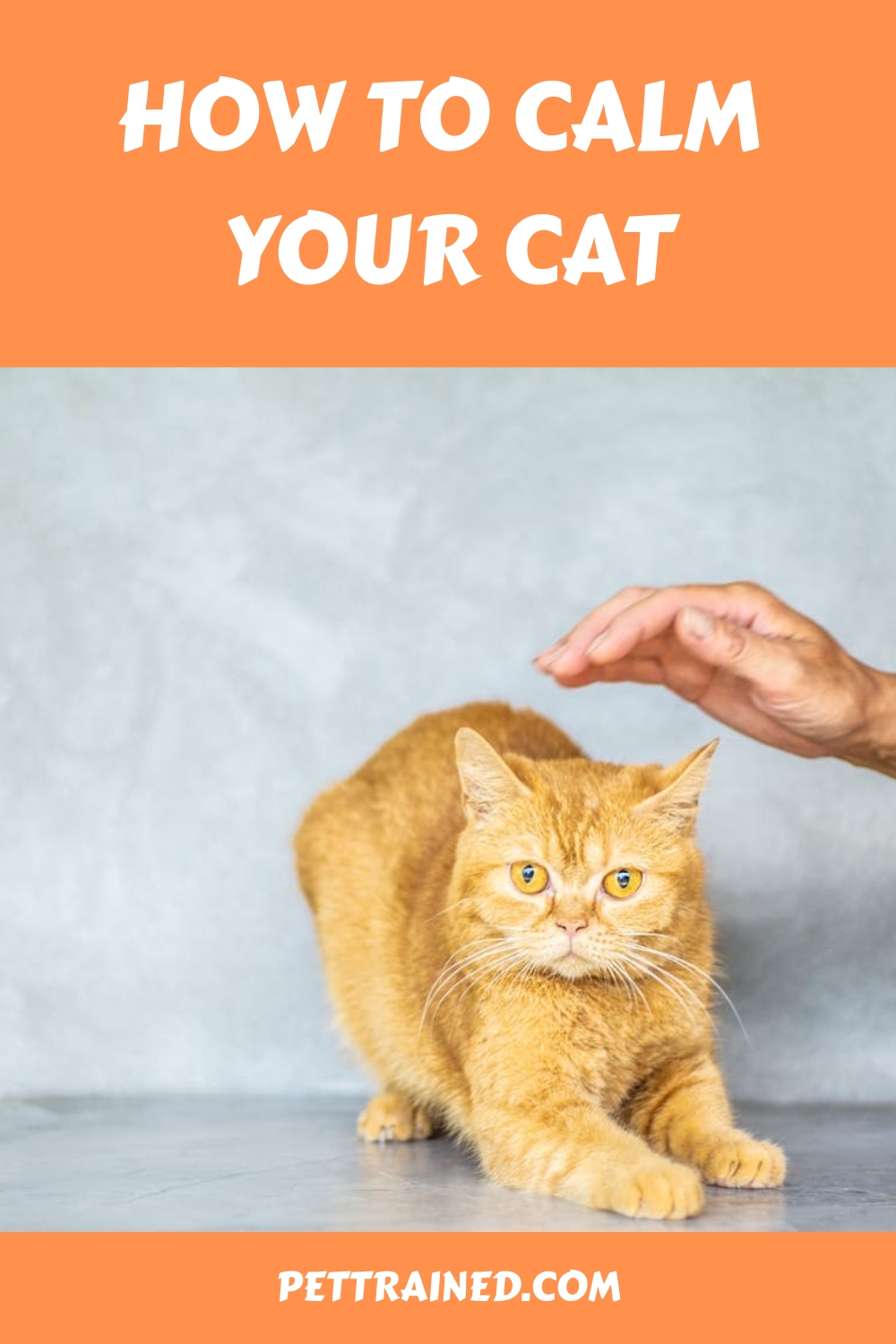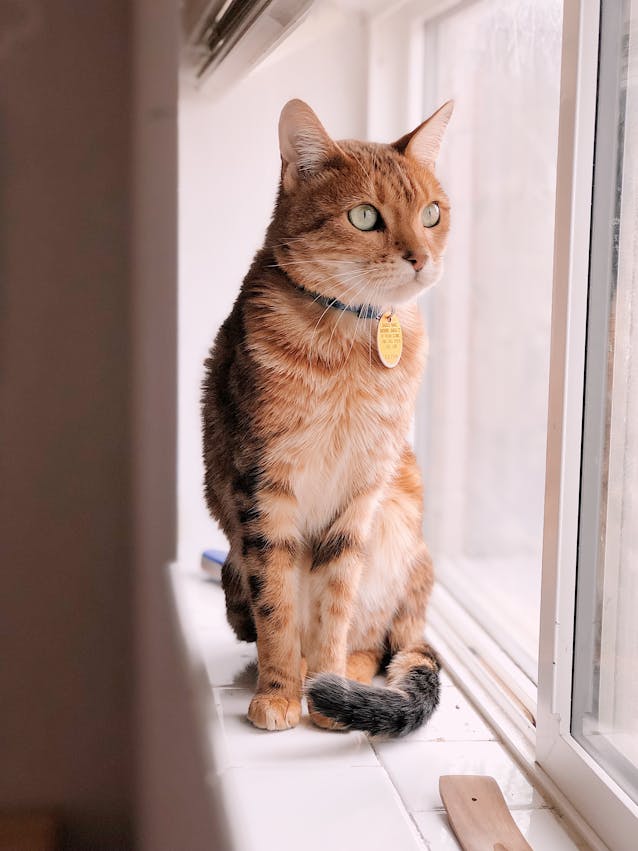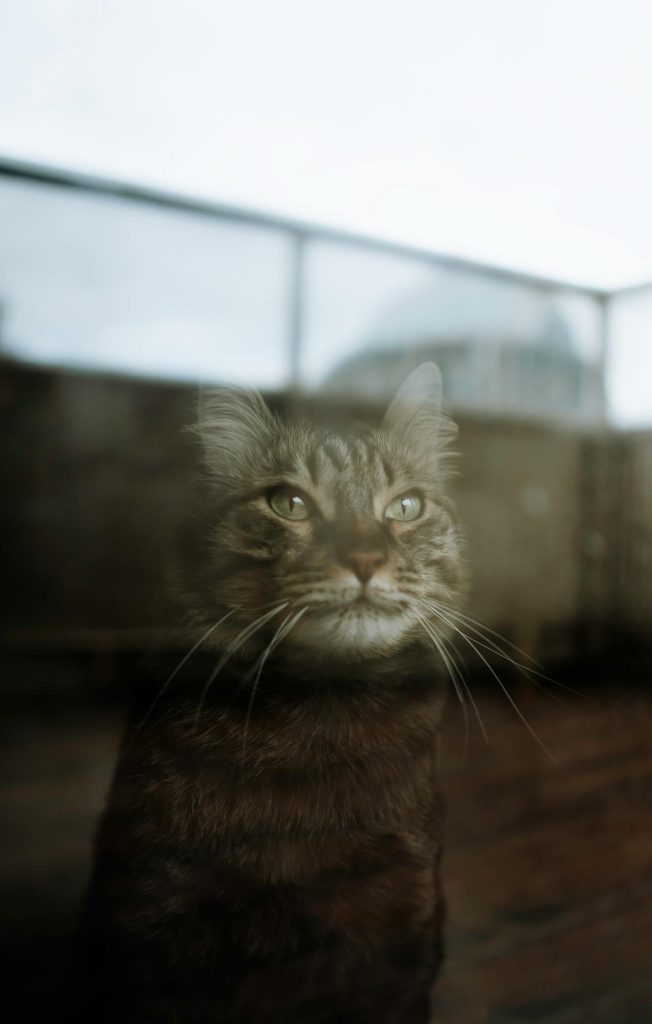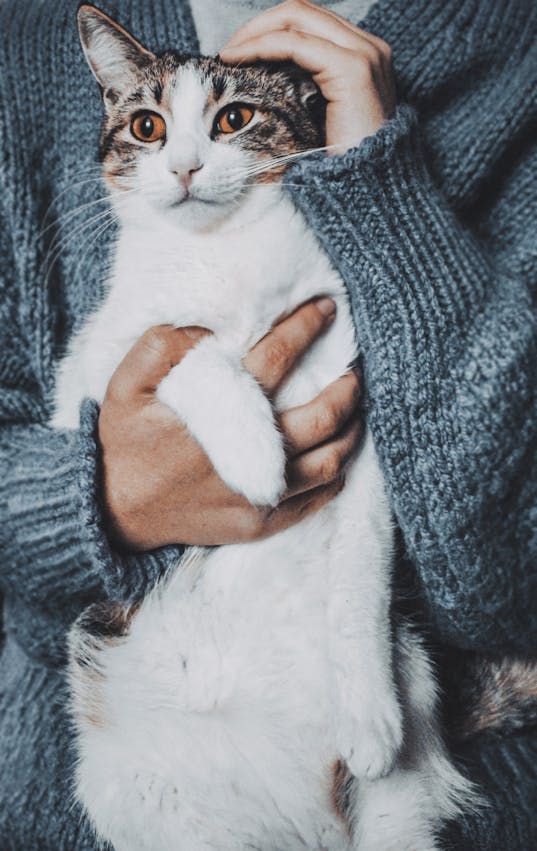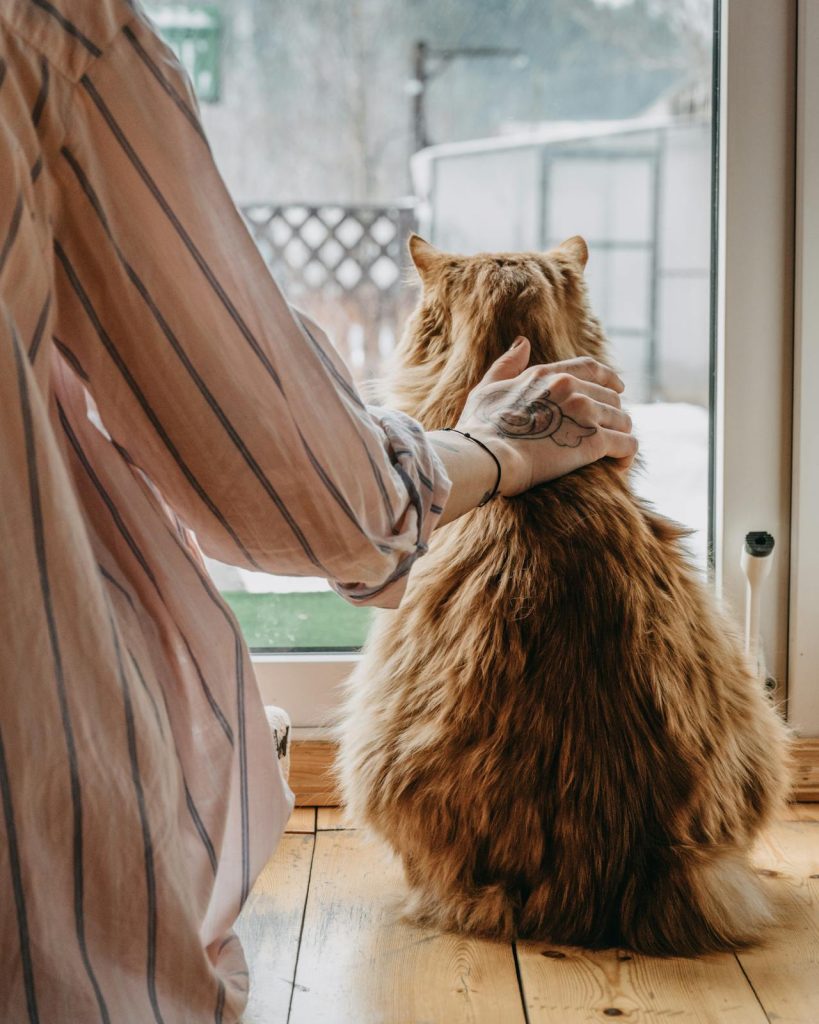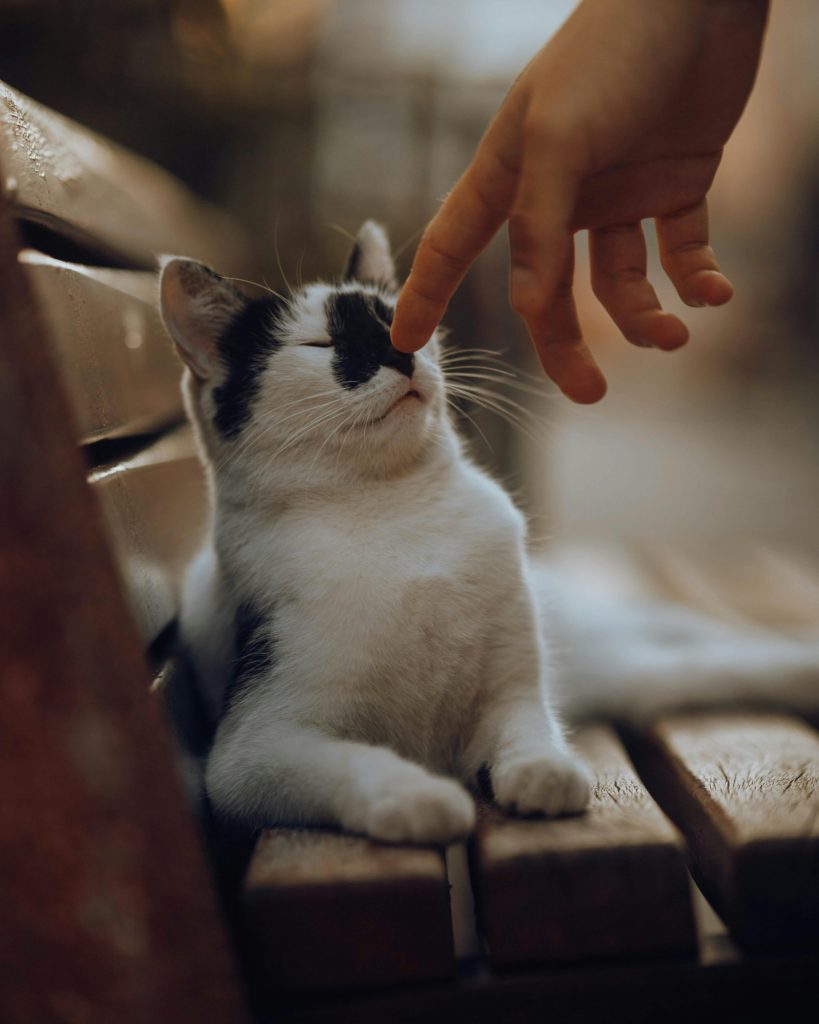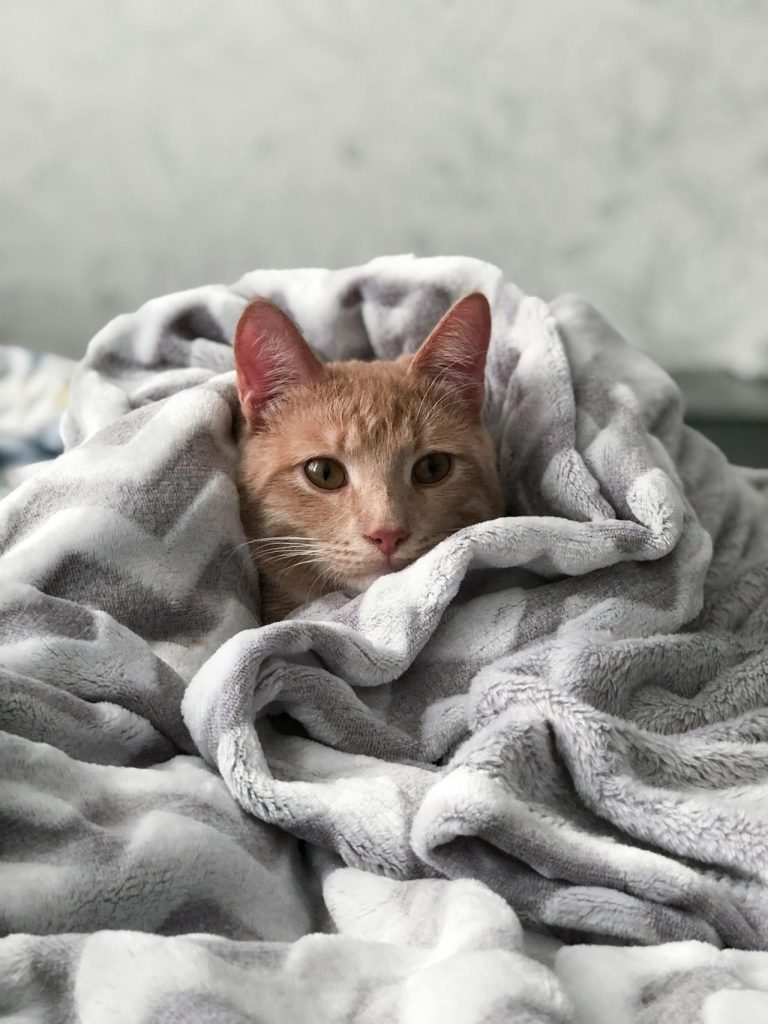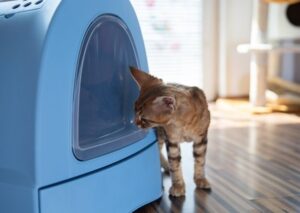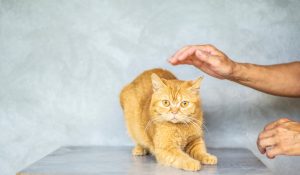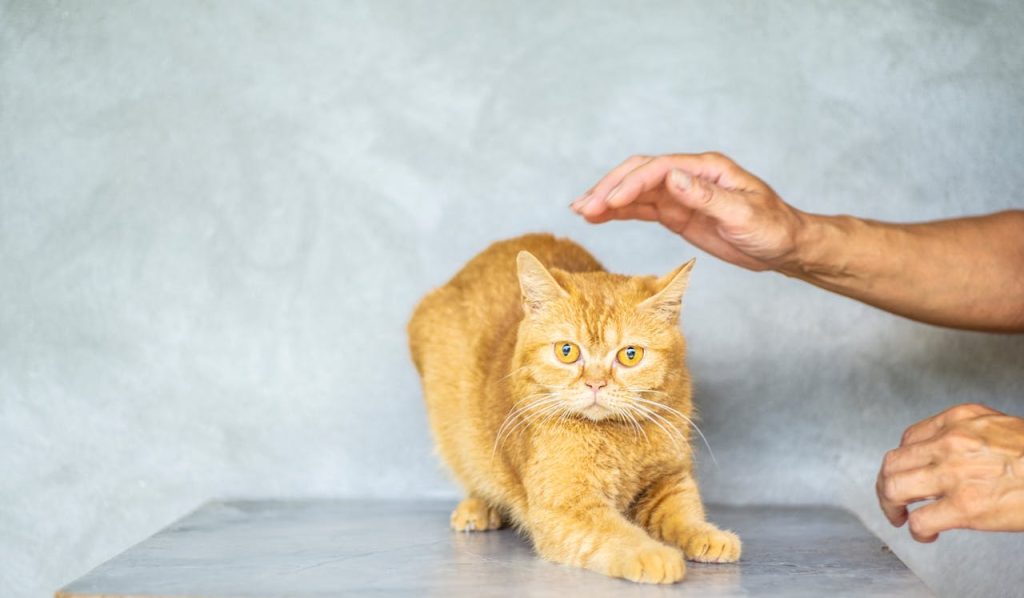
You can calm your cat by recognizing signs of stress, such as changes in behavior, body language, and vocal cues. Minimize environmental stimuli by reducing noise levels, creating quiet zones, and using gentle interaction. Provide a safe space with hideaways and comfort enhancements. Use calming touch techniques like gentle petting, soothing stroke patterns, and targeted touch. Additionally, try pheromone therapy, play calming music, and maintain a regular routine. By understanding your cat’s needs and implementing these strategies, you’ll be better equipped to address their anxiety and promote relaxation, leading to a more harmonious and healthy relationship.
Table of Contents
Key Takeaways
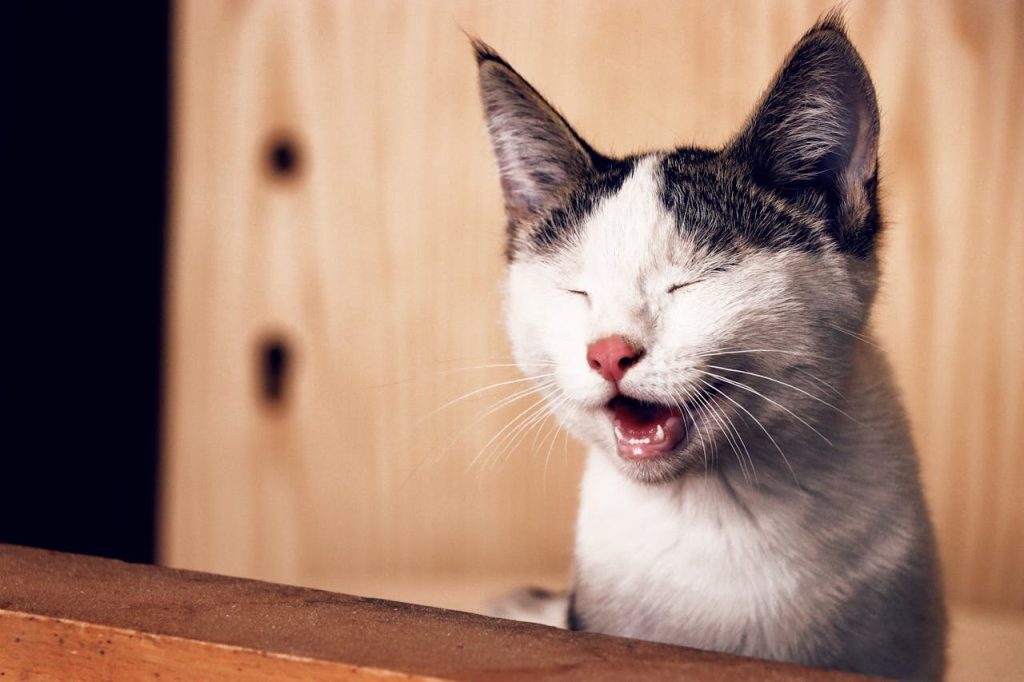
- Recognize signs of stress in your cat, including changes in behavior, body language, vocal cues, and appetite.
- Minimize environmental stimuli by reducing noise levels, creating quiet zones, and using gentle interaction and visual barriers.
- Provide a safe space for your cat to retreat to, using hideaways, comfort enhancements, and accessibility to reduce stress.
- Use calming touch techniques, such as gentle petting, soothing stroke patterns, and targeted touch, to promote relaxation.
Recognize the Signs of Stress
To effectively calm your cat, you need to recognize the signs of stress, which can manifest as changes in behavior, vocalization, or physical posture.
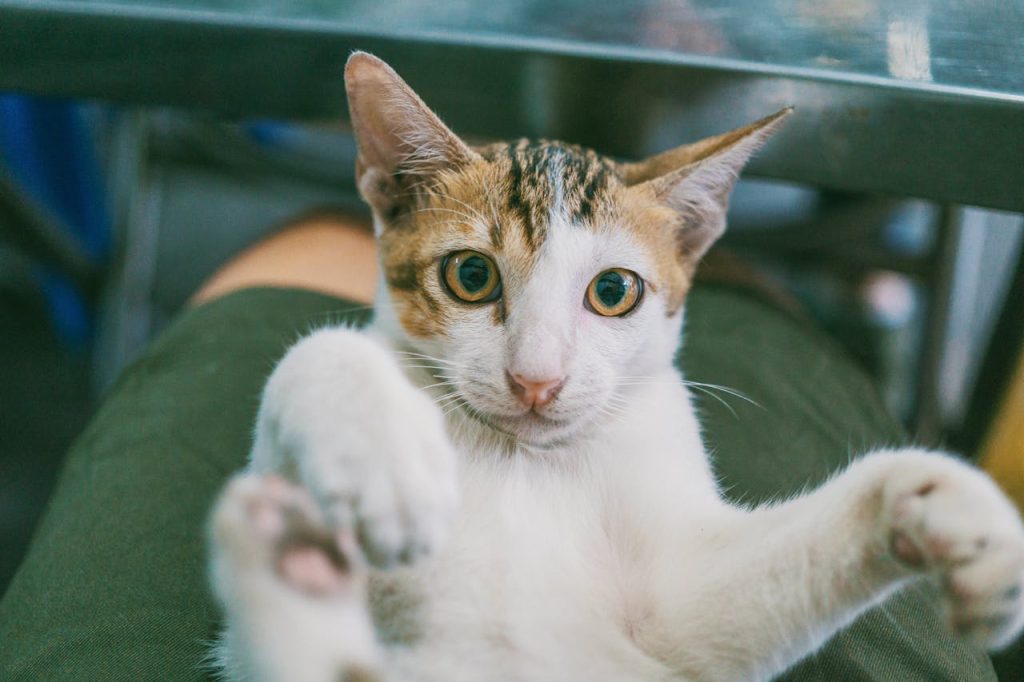
You’ll want to look out for stress indicators, such as anxiety behaviors like pacing, panting, or restlessness. Body language is also a key indicator, so pay attention to your cat’s tail position, ear movement, and facial expressions.
A tense or lowered tail, laid-back ears, or a furrowed brow can all be signs of stress.
Vocal cues like hissing, growling, or excessive meowing can also signal anxiety. Changes in hiding tendencies or grooming habits can be red flags too.
This post contains affiliate links. However all the information provided on this site are my own honest opinions. See more in Disclaimer.
If your cat is normally social but starts hiding, or if their grooming becomes excessive or lacking, it may be a sign of stress.
Additionally, altered appetite or changes in eating habits can be an indicator of anxiety. By recognizing these signs, you can take the first step towards calming your cat and addressing their stress.
Keep in mind that every cat is different, so it’s important to get to know your cat’s individual personality and behaviors to better understand what may be causing their stress.
Minimize Environmental Stimuli
To minimize environmental stimuli that can stress your cat, you’ll want to identify and reduce any overwhelming noise levels in your home.

This can include loud music, construction sounds, or even everyday household noises like vacuuming or laundry machines.
Reduce Noise Levels
By minimizing loud sounds, you can greatly reduce your cat’s stress and anxiety, as cats are highly sensitive to auditory stimuli.
Also See:
To create a more peaceful environment, establish quiet zones in your home where your cat can retreat from loud noises. This can be a separate room or a designated area with minimal external noise.
You can also implement soundproofing tips to minimize sound transmission. Seal gaps and cracks in walls, doors, and windows using acoustic sealants or weatherstripping.
Additionally, consider using mass-loaded vinyl or acoustic panels to absorb sound waves.
When interacting with your cat, be mindful of your voice levels and movements. Sudden loud noises can startle your cat, so try to move quietly and speak in a soft voice.
You can also play calming music or white noise to mask background sounds.
Block Visual Stressors
Visual stressors in your cat’s environment, such as other pets, people, or even birds outside a window, can cause anxiety and stress. Minimizing these stimuli is essential for creating a calming atmosphere.
You can achieve this by blocking your cat’s line of sight to potential stressors using visual barriers like curtains, blinds, or even a room divider. Strategically placing these barriers can greatly reduce your cat’s stress levels.
You can also use color patterns to your advantage. Cats are highly sensitive to colors and patterns, and some can be overstimulating.
By using calming colors like blue, green, or neutral tones in your home decor, you can create a soothing atmosphere that reduces visual stress.
Additionally, you can try placing a calming visual stimulus, such as a pheromone-infused product or a calming image, in your cat’s line of sight to counteract any potential stressors.
By taking these steps, you can effectively block visual stressors and create a more calming environment for your cat.
Provide a Safe Space
When creating a calming environment for your cat, providing a quiet, secure space where it can retreat from stressors is essential. You can achieve this by setting up cat hideaways in strategic locations around your home.
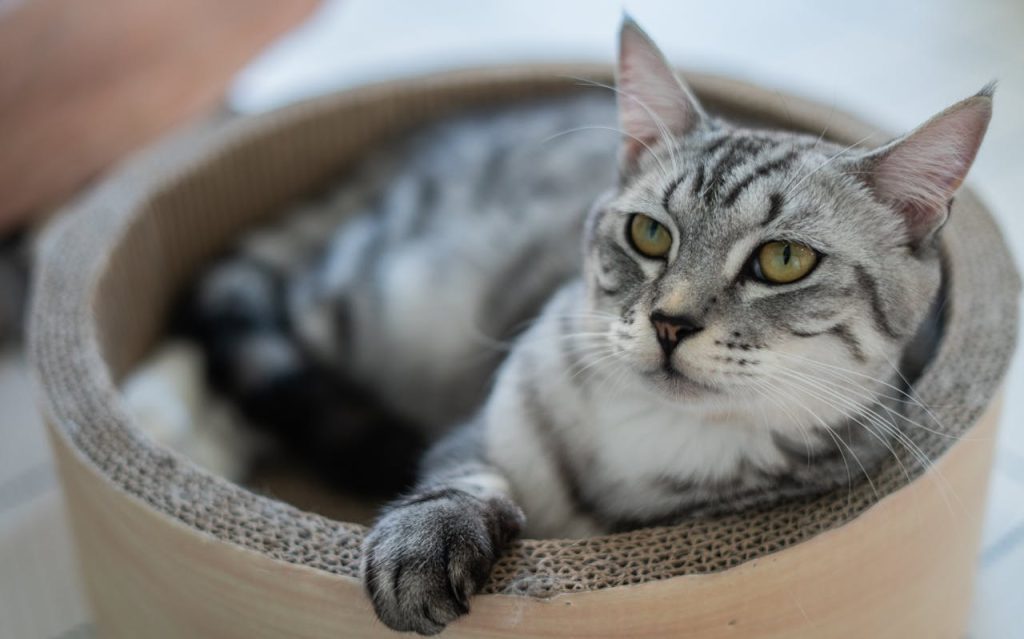
These hideaways can be as simple as cardboard boxes or as elaborate as custom-built enclosures. The key is to provide a cozy, enclosed space where your cat can feel safe and relaxed.
To make these hideaways even more inviting, add some cozy blankets or towels. Cats often associate soft textures with feelings of comfort and security, so incorporating these elements can help reduce stress and anxiety.
You can also try placing a familiar scent, such as a blanket that smells like you, in the hideaway to provide additional reassurance.
Use Calming Touch Techniques
You can use calming touch techniques to help reduce your cat’s stress and anxiety.
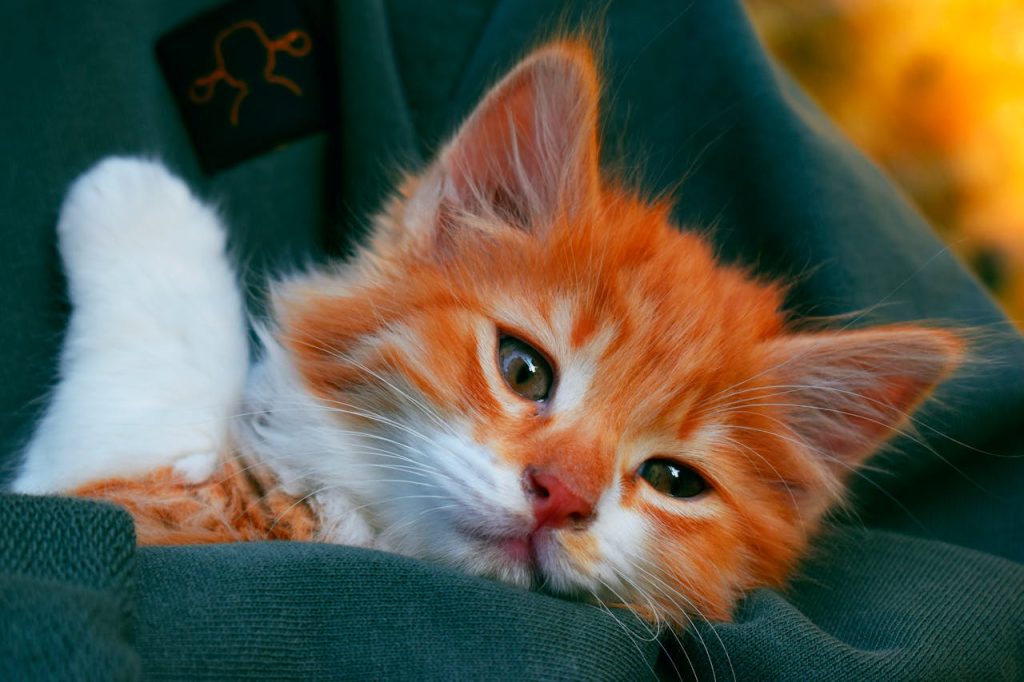
By employing gentle petting methods, soothing stroke patterns, and calming massage techniques, you’ll be able to calm your cat and promote relaxation.
Let’s explore these techniques in more detail to help you become proficient in using calming touch to soothe your feline companion.
Gentle Petting Methods
Employing gentle petting methods is essential in calming your cat, as these soothing touch techniques help slow down its heart rate and promote relaxation.
When you use gentle strokes, you’re mimicking the comforting touch your cat’s mother provided during kittenhood. This familiar sensation can calm your cat’s nervous system and reduce anxiety.
To apply gentle petting methods, start by letting your cat approach you and initiate contact. Then, lightly place your hand on its head, cheeks, or behind its ears, using long, flowing strokes to pet its fur.
As you pet your cat, focus on using rhythmic petting, applying gentle pressure in a consistent, repetitive pattern. Avoid sudden movements or intense pressure, which can startle or overwhelm your cat.
Instead, maintain a steady, soothing touch, adjusting your strokes according to your cat’s response.
Trending in Cats:
If your cat seems to enjoy the touch, you can gradually increase the duration and intensity of the petting. Remember to remain attentive to your cat’s body language, ending the petting session if it shows signs of stress or discomfort. See also 25 Cat Facts For Cat Owners.
Soothing Stroke Patterns
Building on the principles of gentle petting, soothing stroke patterns take touch techniques to the next level by incorporating specific motions designed to calm your cat’s nervous system and induce a state of relaxation.
You’ll want to pay close attention to the stroke rhythm, as a slow, steady pace can have a profound impact on your cat’s emotional state. For best results, mirror your cat’s natural fur direction, working from head to tail.
This reduces discomfort and allows your cat to fully surrender to the sensory experience.
As you gently stroke your cat’s coat, focus on maintaining light, even pressure. For areas of high sensitivity, such as the ears, cheeks, and tail base, use a gentle circular motion to soothe.
Avoid applying pressure or rapid movements, as this may trigger anxiety or pain responses.
By mastering these basic stroke patterns, you’ll be able to target areas of tension and encourage release, promoting a state of deep relaxation in your cat.
With practice and attention to your cat’s response, you can develop tailored soothing stroke patterns to use in a variety of settings. See our post on How to Groom a Cat With Matted Hair.
Calming Massage Techniques
Regularly incorporating calming massage techniques into your touch therapy routine can greatly enhance your cat’s relaxation response, reducing stress and anxiety while promoting overall well-being.
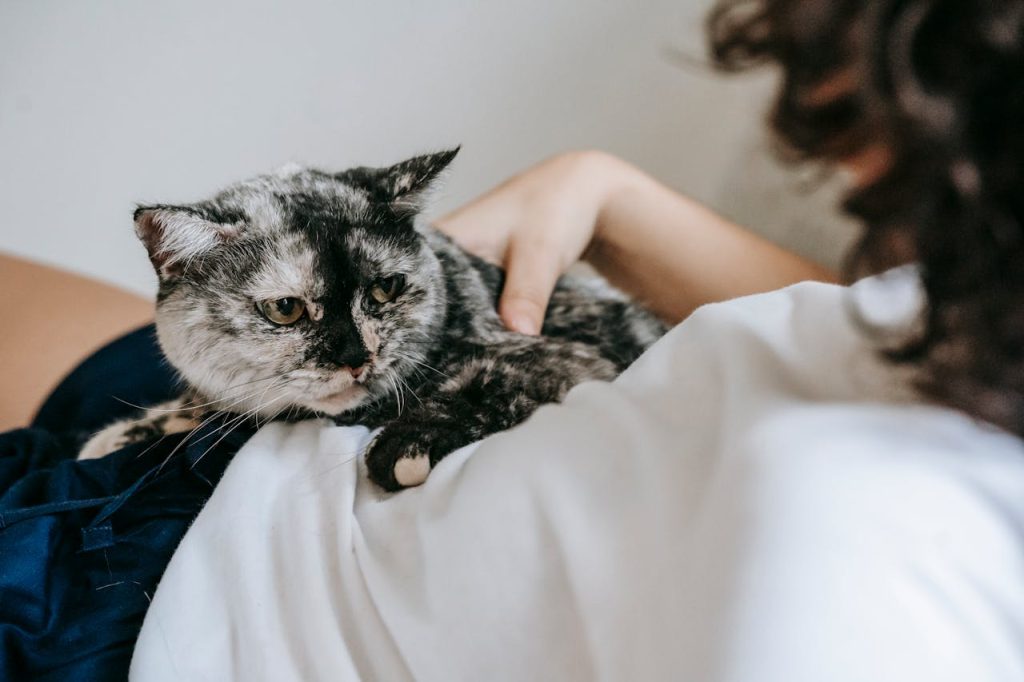
By targeting specific pressure points and relaxation zones, you can help calm your cat’s nervous system and promote a sense of tranquility.
To get started, try incorporating the following calming massage techniques into your routine:
- Gently rub the base of your cat’s ears, where the ear meets the head, to target a key relaxation zone.
- Use your fingertips to apply gentle pressure to the temples, forehead, and cheeks, releasing tension and promoting relaxation.
- Massage the neck and shoulder area, where tension often accumulates, to help calm the nervous system.
- Use long strokes to massage the back, targeting key pressure points along the spine.
Remember to always tailor your massage techniques to your cat’s individual needs and preferences, and to watch for signs of relaxation or stress.
Try Pheromone Therapy
You can mimic the calming scent that mother cats produce to calm their kittens by using synthetic pheromone products, such as diffusers or sprays, in your home.
These products contain synthetic pheromones that mimic the natural pheromones produced by cats, helping to calm and relax them.
Pheromone therapy can be an effective way to reduce stress and anxiety in cats. By using pheromone diffusers or calming sprays, you can create a more calming environment for your cat.
| Product Type | Description | Benefits |
|---|---|---|
| Pheromone Diffusers | Release synthetic pheromones into the air | Reduces stress and anxiety, promotes relaxation |
| Calming Sprays | Contain synthetic pheromones, applied directly to surfaces | Quick and easy to use, reduces stress and anxiety |
| Pheromone Wipes | Pre-moistened wipes containing synthetic pheromones | Portable and convenient, reduces stress and anxiety |
| Combination Products | Combine pheromones with other calming agents | Enhanced stress relief and anxiety reduction |
Play Calming Music
Numerous studies have shown that cats respond positively to calming music, which can help reduce their stress and anxiety by creating a soothing atmosphere.
You can use calming music to create a relaxing environment for your feline friend. The most effective calming music for cats typically features slow tempos, simple melodies, and minimal instrumentation.
When selecting calming music for your cat, consider the following options:
- Classical music, such as piano or guitar pieces, can be soothing for cats.
- Nature sounds, like rain or ocean waves, can create a calming atmosphere.
- Music specifically designed for cats, often incorporating sound frequencies between 200-800 Hz, can be particularly effective.
- Instrumental music with a slow tempo and minimal percussion can help reduce stress.
Maintain a Regular Routine
Establishing a daily routine that includes set times for feeding, play, and sleep helps provide your cat with a sense of stability and predictability.
By maintaining a consistent daily schedule, you’ll help reduce your cat’s stress and anxiety levels. This, in turn, will create a calmer and more relaxed environment for both you and your cat.
To maintain a regular routine, consider the following:
| Daily Activity | Recommended Frequency |
|---|---|
| Feeding Schedule | 2-3 times a day |
| Playtime Consistency | 15-30 minutes, 2-3 times a day |
| Litter Box Routine | Clean daily, change litter completely every 7-10 days |
Additionally, establish a grooming frequency to help your cat stay clean and relaxed. Brush your cat gently 2-3 times a week, or as needed.
By sticking to this routine, you’ll provide your cat with a sense of security and predictability. A regular routine also helps regulate your cat’s internal clock, ensuring they get the rest and relaxation they need.
Remember, consistency is key to maintaining a calm and happy cat. By following these guidelines, you’ll help reduce your cat’s stress and create a more harmonious home environment.
Frequently Asked Questions

You shouldn’t give your cat human anxiety medication. Instead, explore cat medication alternatives and feline anxiety solutions specifically designed for cats. Consult with a veterinarian to determine the best course of treatment for your anxious pet.
You’re caught between a rock and a hard place, wondering if calming treats for cats have side effects. While generally safe, some calming ingredients can cause drowsiness or stomach upset, affecting treat effectiveness, so monitor your cat closely.
You’ll notice your cat’s stress signs, such as rapid breathing and pacing, begin to dissipate within 10-30 minutes as you apply relaxation techniques like gentle petting, soft music, or pheromone therapy, calming them effectively.
Ironically, while you’re seeking relaxation for your cat, some aromatherapy essential oils can actually stress them out. You’ll want to exercise extreme caution due to feline scent sensitivity; research essential oil safety to avoid adverse reactions.
You can help alleviate your cat’s anxiety through dietary changes, incorporating calming herbs like chamomile and valerian root into their food. Additionally, consider adding dietary supplements such as L-theanine or melatonin to promote relaxation.
Conclusion
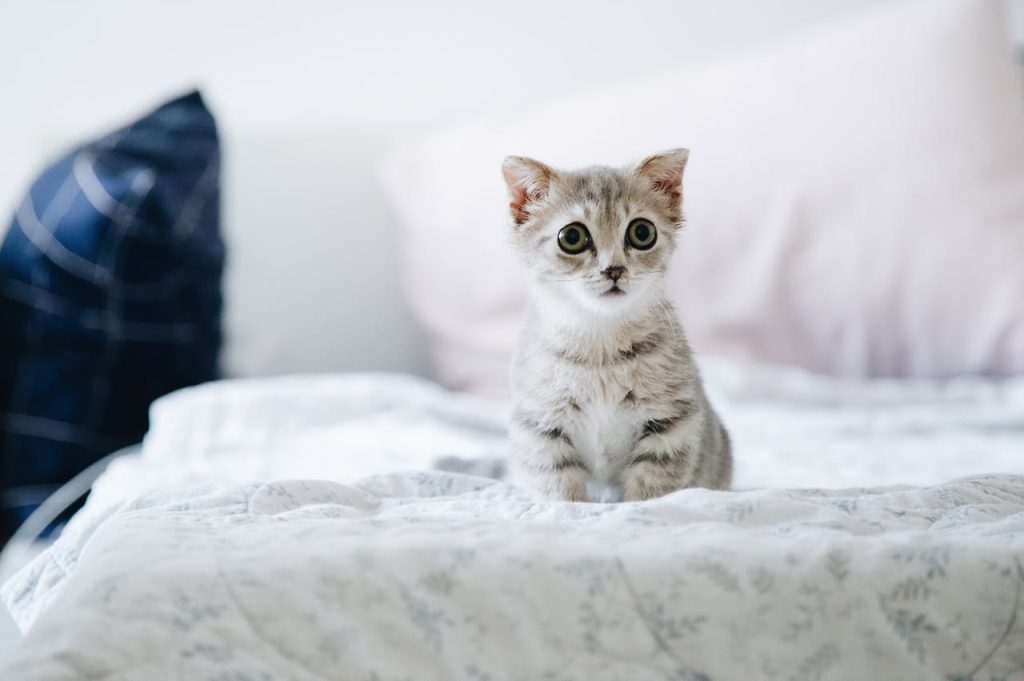
You’ve taken the first steps in calming your cat. By recognizing stress signs, minimizing environmental stimuli, and using calming techniques, you’re on the right track.
Curiously, a study found that 70% of cats exhibit stress-related behaviors, such as pacing or vocalization, when their routine is disrupted.
Maintaining a regular routine can greatly reduce your cat’s stress levels.
Continue to implement these strategies and work with your veterinarian to guarantee your cat’s emotional well-being.
